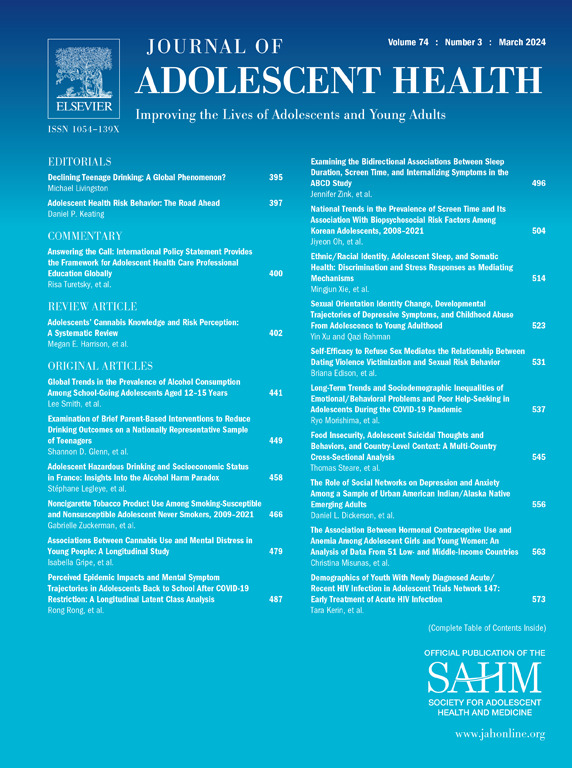儿童期晚期至青春期抑郁症状的欺凌经历时间和性取向差异:一项前瞻性队列研究。
IF 5.5
2区 医学
Q1 PEDIATRICS
引用次数: 0
摘要
目的:女同性恋、男同性恋和双性恋(LGB)青少年比异性恋同龄人报告更多的欺凌和抑郁症状,但没有关于欺凌随时间变化如何影响儿童期到青春期抑郁症状变化的纵向研究。我们测试了11岁至17岁抑郁症状发展轨迹中的性取向差异,以及11岁至13岁受欺凌次数的增加对抑郁症状中性取向差异的影响。方法:采用来自英国的前瞻性出生队列——雅芳父母与儿童纵向研究(Avon Longitudinal Study of Parents and Children) (N = 5037,女性53.38%,白人87.53%)。采用结构方程模型进行分析。结果:LGB青少年在11岁、13岁、14岁和17岁时报告的抑郁症状明显多于异性恋青少年,这些组间差异从11岁到17岁增加,范围从0.21到0.84。从11岁到17岁,异性恋青少年和LGB青少年的抑郁症状都有所增加,其中LGB青少年的增加更大,总效应(标准化回归系数,β) = 0.82。性取向在抑郁症状增加率上的差异可以部分解释为LGB在11 - 13岁期间比异性恋青少年更容易受到欺凌,间接影响= 0.14。讨论:与异性恋青少年相比,LGB青少年从儿童期晚期到青春期早期受欺凌的增加与11岁至17岁抑郁症状的增加率有关。本文章由计算机程序翻译,如有差异,请以英文原文为准。
Timing of Bullying Experiences and Sexual Orientation Differences in Depressive Symptoms From Late Childhood to Adolescence: A Prospective Cohort Study
Purpose
Lesbian, gay, and bisexual (LGB) adolescents report more bullying and depressive symptoms than their heterosexual peers, but there are no longitudinal studies on how changes in bullying over time influence changes in depressive symptoms from childhood to adolescence. We tested sexual orientation differences in the developmental trajectories of depressive symptoms from age 11 to 17 and the influence of increases in being bullied from age 11 to 13 upon increased sexual orientation differences in depressive symptoms.
Methods
The Avon Longitudinal Study of Parents and Children, a prospective birth cohort from the United Kingdom, was used (N = 5,037, 53.38% female, 87.53% White). Analyses were performed using structural equation modeling.
Results
LGB adolescents reported significantly more depressive symptoms than heterosexual adolescents at ages 11, 13, 14, and 17, and these group differences increased from age 11 to 17, ranging from 0.21 to 0.84. Depressive symptoms increased from age 11 to 17 for both heterosexual and LGB adolescents, with a greater increase observed in LGB adolescents, total effect (standardized regression coefficient, β) = 0.82. Sexual orientation differences in the rate of increases in depressive symptoms were partially explained by greater increases in being bullied from age 11 to 13 reported by LGB than heterosexual adolescents, indirect effect = 0.14.
Discussion
Greater increases in being bullied from late childhood to early adolescence are associated with a greater rate of increases in depressive symptoms from age 11 to 17 among LGB adolescents compared to heterosexual adolescents.
求助全文
通过发布文献求助,成功后即可免费获取论文全文。
去求助
来源期刊

Journal of Adolescent Health
医学-公共卫生、环境卫生与职业卫生
CiteScore
10.40
自引率
3.90%
发文量
526
审稿时长
46 days
期刊介绍:
The Journal of Adolescent Health is a scientific publication dedicated to enhancing the health and well-being of adolescents and young adults. Our Journal covers a broad range of research topics, spanning from the basic biological and behavioral sciences to public health and policy. We welcome a variety of contributions, including original research papers, concise reports, literature reviews, clinical case reports, opinion pieces, and letters to the editor. We encourage professionals from diverse disciplines such as Anthropology, Education, Ethics, Global Health, Health Services Research, Law, Medicine, Mental and Behavioral Health, Nursing, Nutrition, Psychology, Public Health and Policy, Social Work, Sociology, and Youth Development to share their expertise and contribute to our mission of promoting adolescent health. Moreover, we value the voices of young individuals, family and community members, and healthcare professionals, and encourage them to submit poetry, personal narratives, images, and other creative works that provide unique insights into the experiences of adolescents and young adults. By combining scientific peer-reviewed research with creative expressions, our Journal aims to create a comprehensive understanding of the challenges and opportunities in adolescent and young adult health.
 求助内容:
求助内容: 应助结果提醒方式:
应助结果提醒方式:


